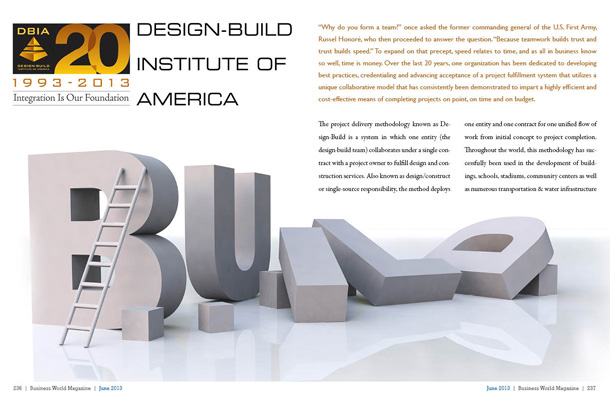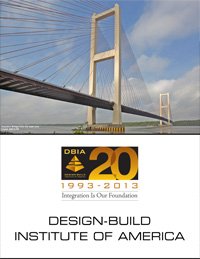

“Why do you form a team?†once asked the former commanding general of the U.S. First Army, Russel Honoré, who then proceeded to answer the question. “Because teamwork builds trust and trust builds speed.†To expand on that precept, speed relates to time, and as all in business know so well, time is money. Over the last 20 years, one organization has been dedicated to developing best practices, credentialing and advancing acceptance of a project fulfillment system that utilizes a unique collaborative model that has consistently been demonstrated to impart a highly efficient and cost-effective means of completing projects on point, on time and on budget.
The project delivery methodology known as Design-Build is a system in which one entity (the design-build team) collaborates under a single contract with a project owner to fulfill design and construction services. Also known as design/construct or single-source responsibility, the method deploys one entity and one contract for one unified flow of work from initial concept to project completion. Throughout the world, this methodology has successfully been used in the development of buildings, schools, stadiums, community centers as well as numerous transportation & water infrastructure projects, constantly proving to be a more effective alternative to the traditional design-bid-build model (a system of separate entities, separate contracts, separate work).
While this methodology has long been embraced in Europe and Canada, over the last 15 years, design-build has increasingly emerged throughout the United States and continues to be one of the most dynamic trends in design and construction today. Owners are increasingly relying on design-build to not only achieve best value, but also adhere to schedule, cost and quality objectives.
The proliferation of this process can be largely attributed to the efforts of the Design-Build Institute of America, the only organization which defines, teaches and promotes best practices in design-build.
This year marks the 20th Anniversary of the creation of the DBIA and Louis Jenny, the Institute’s Vice President, is encouraged to see how this delivery system has not only been embraced by industry, but Federal and State government too. He credits such achievement to a few forward thinking engineers and contractors who resolved to define and develop the delivery model which is being deployed today.
Jenny says that all began in 1993 with principals from firms that included the Haskell Company, Gray Construction and Panco. These organizations were essentially using a design-build formula in their respective work and had realized the benefits that could be achieved. And though both the building and design industries were being served by various trade associations with their own respective goals and agendas, there was nothing in place to advocate for the effectiveness of the model these companies were using. After meeting in Washington D.C. in February of 1993, these company principals along with others determined to create a steering committee and appoint staff thus spurring the Design-Build Institute of America into creation.
Their activities coincided around the same time that the U.S. Green Building Council was formed, who has since had incredible success seeing the adoption of their LEED Certification model. Likewise, the DBIA’s credentialing and training initiatives have seen widespread penetration through industry and national markets, yet as Jenny indicates, that has not happened without the overcoming of resistance. He  says the biggest push of the initial founders was getting Federal legislation passed that allowed design-build to be used in municipal infrastructure projects. The challenge with this involved the manner in which lawmakers interpret legislation known as The Brooks Act, a mandate relating to the selecting of architects based on qualifications which also effectively hinders them from professionally teaming-up with construction companies, thus compelling what has been the traditional RFP approach. The DBIA achieved a major victory in having the Federal Government revise their position and embrace the design-build model, but  Jenny says state governments continued to enforce their own manner of “mini-Brooks Act†policies. Over the years, DBIA has successfully overturned those policies, but some states have yet to catch-up. For instance, New York only recently deployed design-build in relationship to a highway and bridge project, a fact that Jenny sees as a victory. He says many states will often allow the model on a pilot-project and assess the results before formally adopting the practice.
Design-Build Benefits
In that it streamlines project delivery through a single contract between an owner and the design-build team, the fundamental difference with design-build methodology versus the old approach, involves the saving of money and time. Design-build transforms the relationship between designers and builders into an alliance that fosters collaboration and teamwork. When there is such unity from the outset of a project, Jenny says an integrated team can more readily incorporate BIM and LEED certification goals. Owners additionally benefit from quicker fulfillment of work; collaborative project management allows work to be completed faster and with fewer problems. An integrated team is geared toward efficiency and innovation which better accommodates cost savings. Projects relying on this methodology also reflect greater quality as design-builders strive to meet performance needs, not minimum design requirements, and will often collectively develop innovations to deliver a better project than that even initially imagined. Since one entity is held accountable for cost, schedule and performance, there is decreased administrative burden and owners can more readily focus on the project rather than managing disparate contracts. As the design-build team assumes risk, this is eliminated for the owner, who can also appreciate that the closing of warranty gaps virtually eliminates the owner from potential litigation claims.
For the practitioners of design-build, there are also benefits. In addition to having less administrative burden born through the streamlining of communication between designers and builders, practitioners can also experience higher profit margins which stems from having an integrated team equally committed to controlling costs.
Jenny says the advantages in this methodology are readily evident when considering the traditional model, when multiple contracts are awarded to autonomous low bidders and the builder works off an architectural design completed months earlier. A process that means should any specification need to be altered, the builder has to go back to the owner, who then goes back to the architect who is already working on some other project, but then make the necessary changes, goes back to the owner, who then goes to back to the builder in a tedious, if not frustrating, cycle of requests for information and change orders which all can negate timely, efficient, cost effective fulfillment of the job at hand.
To be sure, design-build provides a very differentiated system of delivery, which relies on a different type of skill-set and service process than traditional models.
Fortunately, the DBIA also serves as a repository of all best practices related to design-build. The Institute is also tasked in the conducting of workshops and training, as well as the credentialing of practitioners who are increasingly seeking this certification to not only distinguish their operational expertise, but impart greater service to their customers. The DBIA also annually pays honor to the practitioners and project leaders whose efforts in industry help showcase the elevation of services and structural achievements which can be realized through this dynamic delivery system.
For Online information about the Design-Build Institute of America or how to secure Design-Build Certification, visit www.dbia.org








